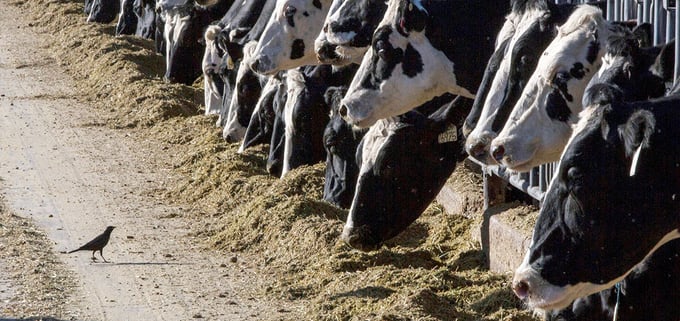June 21, 2025 | 03:58 GMT +7
June 21, 2025 | 03:58 GMT +7
Hotline: 0913.378.918
June 21, 2025 | 03:58 GMT +7
Hotline: 0913.378.918

Three U.S. states have reported sick dairy cows with a flu virus that appears to match the one killing birds worldwide.
The bird flu virus that has wreaked havoc around the world appears to have surfaced in U.S. dairy cows, the first time this viral subtype has been documented in any cattle. Three U.S. states—Texas, Kansas, and New Mexico—on 25 March reported cows sickened with what scientists are presuming is the same H5N1 strain of influenza that has killed hundreds of millions of poultry and wild birds.
The cattle infections are spoiling milk and causing limited disease in mostly older animals. Dead birds have also been found on some of the farms, which may explain the source of the virus. Public health officials have stressed that the risk to humans from the virus remains low.
The so-called highly pathogenic avian influenza (HPAI) virus spreading in birds has already been documented to infect dozens of other mammalian species, but rarely spreads between them. Earlier this month, HPAI was found in a goat in Minnesota, the first case in U.S. livestock.
Gregory Gray, an epidemiologist at the University of Texas Medical Branch, calls the new detections in cows across multiple states a “worrisome” development because it may signal this bird flu strain is spreading directly between cattle, instead of via birds, and has mutated in ways that could allow it to better infect people. But preliminary studies on the affected cows show no signs that the virus has changed, the National Veterinary Services Laboratories said in a statement yesterday.
The U.S. Department of Agriculture (USDA) is not requiring farmers to cull affected herds, as it does when the virus attacks poultry farms. USDA officials stress that pasteurization kills the virus in any milk produced by an infected cow.
Several other of the four influenza virus types are known to infect cattle, but this is the first HPAI to sicken them. Only Texas has officially confirmed that the bird flu found in its cows is the H5N1 subtype, and none of the three states have yet reported whether it is the clade causing widespread death in birds, 2.3.4.4b. USDA said in a statement to Science that “testing from Texas shows consistency with the strain seen in wild birds,” and that federal and state scientists are rapidly trying to complete genetic testing.
Gray, who has an ongoing study to track infections that spread between cattle and their farmers, spoke with Science about the discovery of the bird flu in cattle. The interview has been edited for brevity and clarity.
A: It’s worrisome. We most recently saw the infections in goats, and we’ve all seen the wildlife being affected with the hotter pathogenic avian flu, including the strange infection of carnivores—bears and wolves. Who knows what’s next? It’s disturbing. We need to figure this thing out, because if the virus continues to change, it could move into other species, including humans. It may be in humans already. We just have to keep a pulse on it. And if we don’t work together with agriculture, we won’t know very well what’s circulating.
A: In some ways. These influenza viruses are changing all the time, and there’s pretty good evidence that all four types have been infecting cattle for a number of years. In fact, there’s a very nice report published in 2019. But in that same report, the authors said that maybe there’s something about the cattle that makes them sort of immune to serious disease and transmission? Well, something has changed, because there’s a multiple state epizootic with animals becoming ill, and the likelihood that the transmission is from cow to cow and farm to farm is much higher than before.
A: We don’t know. I don’t think anybody’s done those experiments. I would think that would be one of the things that people would want to investigate rather quickly.
A: That’s a great question. There’s mixing of habitat certainly. There’s a sharing of water. We found equine influenza in camels in Mongolia, and it was probably the sharing of a water hole in in the desert. So there are probably multiple ways that the wild birds can mix with cattle.
A: There was talk that some of the dairy cattle were suffering gastrointestinal illnesses. Has this virus changed in some way that it’s finding new receptors in cattle?
A: We’ve been funded now for about 8 months. Initially, we thought we would be able to work with many farms in Texas, because they’re concerned about keeping their animals free from disease. But there’s been a real resistance to collaborating with us. There’s concern that we might find something that would damage their business. Well, now they have something that’s damaging to their business. And we’re standing by ready to assist in a way that would help us identify the transmission pathway. Is a viable virus aerosolized? Is it coming out in the feces? Or is it simply a respiratory pathogen that is moving through direct contact from cattle to cattle? I would think that there’s some indication with this rapid multistate spread that this thing is airborne.
(science)

(VAN) Poultry production in Poland, which has only started recovering from devastating bird flu outbreaks earlier this year, has been hit by a series of outbreaks of Newcastle disease, with the veterinary situation deteriorating rapidly.

(VAN) Extensive licensing requirements raise concerns about intellectual property theft.

(VAN) As of Friday, a salmonella outbreak linked to a California egg producer had sickened at least 79 people. Of the infected people, 21 hospitalizations were reported, U.S. health officials said.

(VAN) With the war ongoing, many Ukrainian farmers and rural farming families face limited access to their land due to mines and lack the financial resources to purchase needed agricultural inputs.

(VAN) Vikas Rambal has quietly built a $5 billion business empire in manufacturing, property and solar, and catapulted onto the Rich List.

(VAN) Available cropland now at less than five percent, according to latest geospatial assessment from FAO and UNOSAT.

(VAN) Alt Carbon has raised $12 million in a seed round as it plans to scale its carbon dioxide removal work in the South Asian nation.